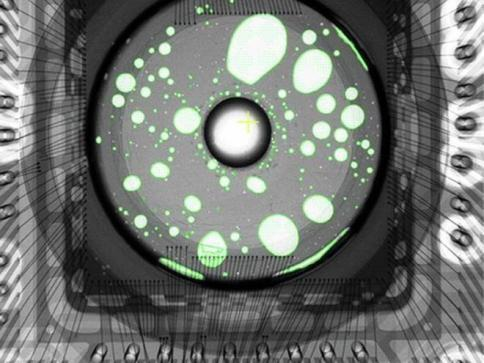Industrial CT and X-ray Testing
Release time:2023-12-05Publisher:Jeenoce
In the field of non-destructive testing, there is a pair of brother schemes - industrial CT testing and X-ray testing, both of which use X-rays to detect the interior of objects. So, how is X-ray generated?
From a scientific principle, X-rays are particle streams generated by the transitions of electrons in atoms between two energy levels with vastly different energies, and have wavelengths between ultraviolet and ultraviolet radiation γ Electromagnetic radiation between rays. By German physicist W K. Roentgen was discovered in 1895, hence it is also known as the Roentgen ray.
The wavelength of Roentgen rays is very short, ranging from 0.01 to 100 angstroms, and they have high penetration ability. They can penetrate many substances that are opaque to visible light, such as ink paper and wood. This invisible radiation can cause visible fluorescence in many solid materials, sensitize photographic films, and ionize air. So, engineers utilized the characteristic of X-rays to develop various X-ray detection devices.
Starting from the mid-20th century, with the development of computer technology, X-ray imaging has taken on a new direction of development, namely CT imaging. CT, also known as three-dimensional X-ray scanning, uses non-destructive X-ray perspective technology to rotate the object under test 360 ° and penetrate it through a single axial plane of radiation. Based on the different absorption and transmission rates of radiation by each part of the object under test, penetration images from each angle are collected, Afterwards, computer operations are used to reconstruct the physical image of the object to be tested. From this, it can be seen that CT can display the three-dimensional structure and internal structure of objects, which has made a qualitative leap compared to the two-dimensional X-ray scheme. Technically speaking, CT tomography technology is the best means of non-destructive testing and evaluation of products. Industrial CT uses tomography technology to achieve non-destructive visualization measurement of products, assembly defects, and material analysis. Without being obscured by surrounding detail features, the spatial position, shape, and size information of the target features can be directly obtained.

The X-ray detection scheme can intuitively display the size and shape of internal defects in the workpiece, making it easy to determine the nature of defects. The X-ray film can be used as the original record for inspection, which can be studied by multiple parties and stored for a long time. It has high sensitivity for non-destructive testing of thin-walled workpieces. Sensitive to volumetric defects, the planar distribution of defect images is true and the size measurement is accurate. There is no strict requirement for the surface smoothness of the workpiece, and the grain size of the material has little effect on the detection results. It can be applied to the detection of internal defects in various materials, so it is widely used in the welding quality inspection of pressure vessels.
However, the X-ray testing method consumes high equipment costs such as X-ray film, has a long film evaluation cycle, slow inspection speed, and low sensitivity to detecting thick walled workpieces. It is only suitable for detecting volumetric defects such as pores, slag inclusions, shrinkage, and porosity. It can be qualitative but not quantitative, and is not suitable for structures with cavities. The inspection sensitivity of diagonal welding and T-joints is low, It is not easy to detect defects such as cracks and lack of fusion with small gaps, as well as internal delamination defects in forgings, pipes, rods, and other profiles.
In addition, X-rays are harmful to the human body and require appropriate protective measures, so the limitations are also significant.
The industrial CT scheme has significant advantages:
Firstly, industrial CT technology produces high-resolution tomographic images of the tested object, and more importantly, industrial CT detection is not limited by the geometric structure of the tested workpiece;
Secondly, industrial CT not only displays the tested sample in two-dimensional images, but also performs three-dimensional reconstruction on the two-dimensional cross-sectional images of the workpiece. The reconstruction results can intuitively distinguish the internal details of the tested object, including: the internal composition structure, material, whether there are defects at the section of the workpiece being tested, as well as the shape, size, position, etc. of the internal defects of the workpiece, and the target information inside the workpiece is clear, Will not be obstructed by other interfering substances;
Furthermore, industrial CT technology has higher spatial and density resolution, wider adaptability, and can be applied to detection at different grayscale levels;
Furthermore, industrial CT images are easy to recognize and understand, resulting in more accurate detection results, and so on
There is another obvious development direction for industrial CT, which is that the main way to detect and identify defects in industrial CT slice images is still through manual judgment by professionals. This recognition method mainly relies on the experience of inspectors, and the detection results are often subject to subjective judgment interference from inspectors, which is not objective enough.
With the advent of big data, cloud computing, and especially the quantum era, many companies have begun to research intelligent defect detection methods, eliminating the subjective interference of human consciousness on detection results, relying on a large amount of actual data as a basis for defect recognition, improving efficiency while ensuring detection quality. AI intelligent recognition and resolution of sample information will become a development direction in the field of industrial CT detection, This is also an inevitable trend in the development of defect detection technology in the future.

